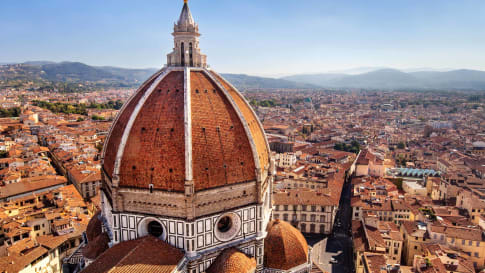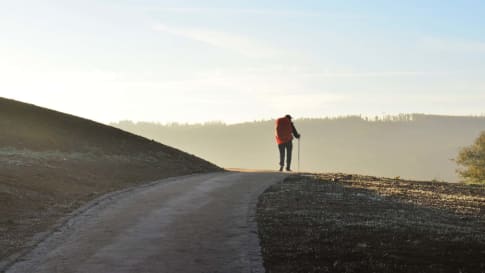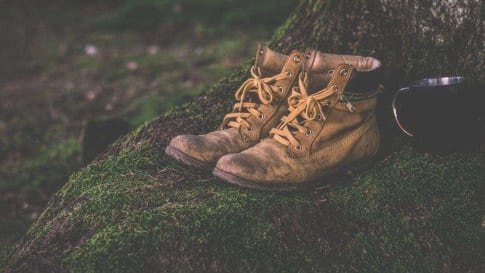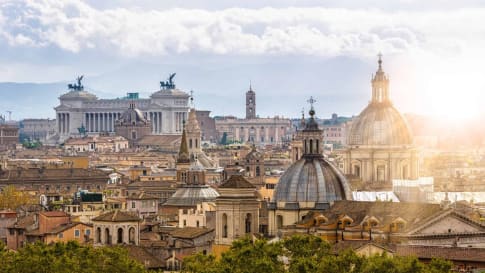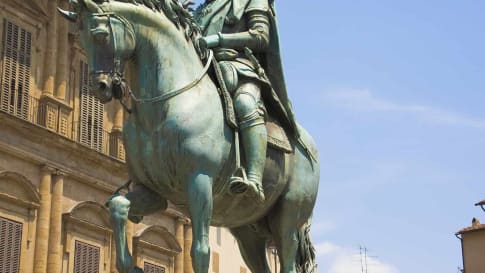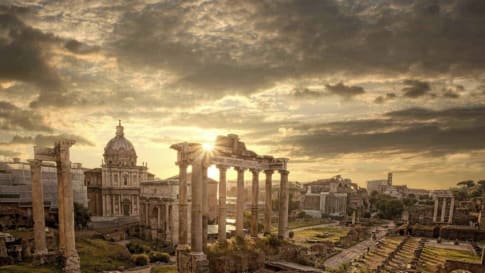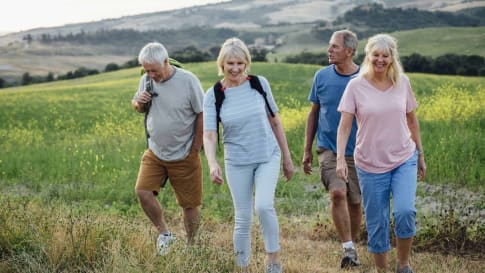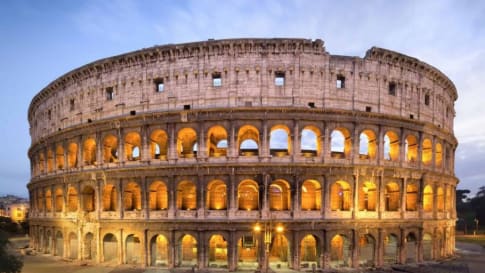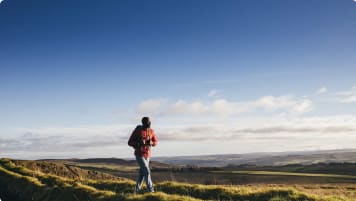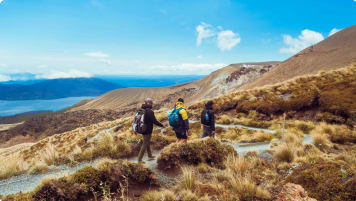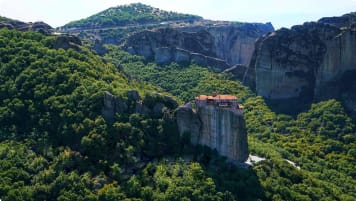Via Francigena Walking Tour: Great St. Bernard Pass to Rome
An escorted tour that walks sections of the ancient pilgrimage route Via Francigena. Our small group is joined by Local guides to share knowledge and authentic experiences as our group of like minded people make their way to Rome.
From $9,220USD
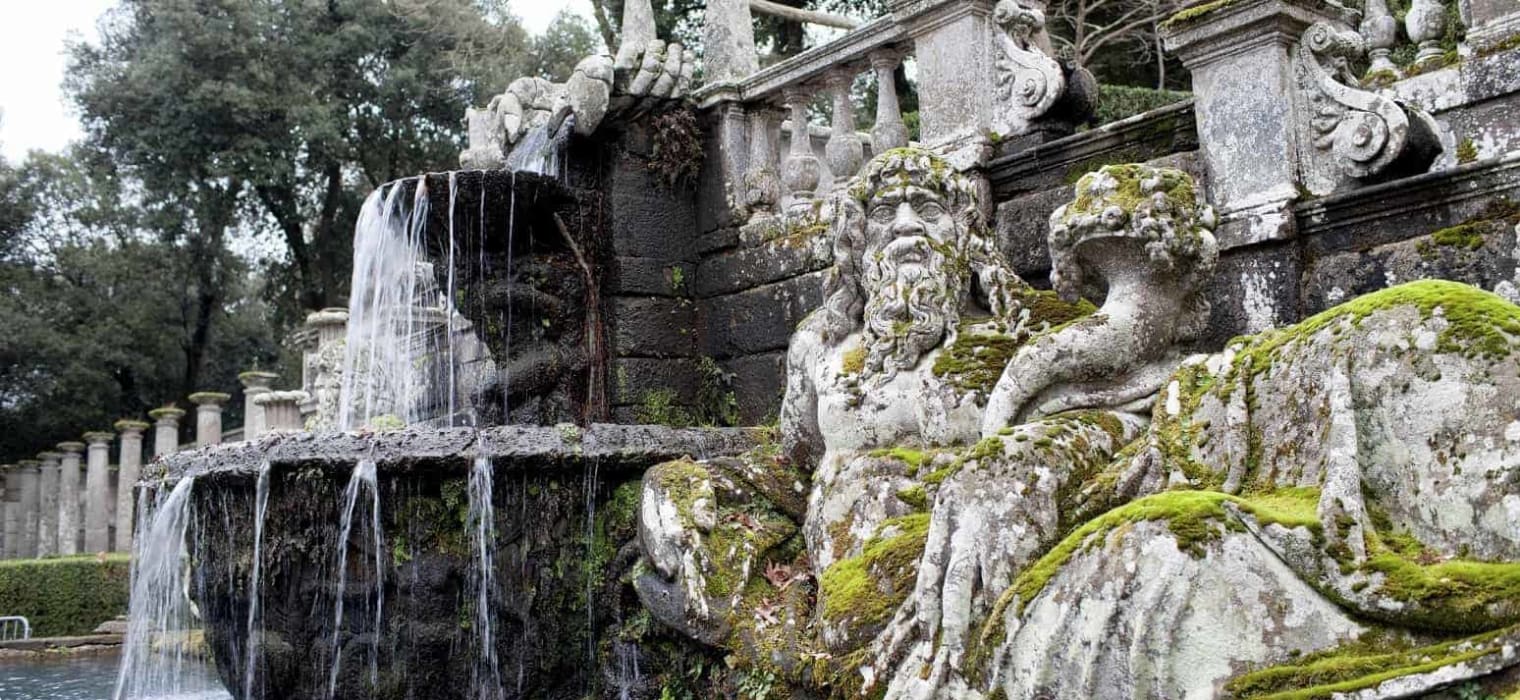
Highlights
- 1. Visit the St Bernard Monastery (Great St Bernard Hospice), located high in the Alps (2,400 metres) and home of the large Saint Bernard dog breed.
- 2. Enjoy a full-day sightseeing tour in Florence, birthplace of the Renaissance.
- 3. Visit Viterbo, which once rivaled Rome as the papal residence in the mid-13th century.
- 4. See the wondrous Sistine Chapel and other breathtaking artwork in the Vatican Museums.
Departure Dates
| Departure Date | Price |
|---|---|
| 01 October 2025 Ends 17 October 2025 • 17 days $9,583 Twin $10,571 Single Available | Selected |
| 30 March 2026 Ends 15 April 2026 • 17 days $9,748 Twin $10,740 Single Available | |
| 28 September 2026 Ends 14 October 2026 • 17 days $9,748 Twin $10,740 Single Available | |
| 29 March 2027 Ends 14 April 2027 • days $10,013 Twin $11,004 Single Available | |
| 27 September 2027 Ends 13 October 2027 • days $10,013 Twin $11,004 Single Available |
Via Francigena Walking Tour: Great St. Bernard Pass to Rome
Odyssey offers easy, convenient, and relaxed escorted small group tours across Western Europe and beyond. We explore Italy’s natural beauty, its ancient Roman, and Imperial heritage, its World Heritage Sites, and world famous cities, all with some truly spectacular scenery along the way. This and more is all waiting to be explored on one of Odyssey’s small group tours of Italy with like minded people designed for the senior traveller.
Join Odyssey Traveller on a small group package tour for mature and senior travellers, as we walk sections of the ancient pilgrimage route Via Francigena, or The Way Through France, a journey that takes us from Geneva, Switzerland, through the Great St Bernard Pass and several Italian towns, until we reach Rome, the Eternal City. These Walking tours are suitable for couples and solo travellers with a reasonable level of fitness.
About the Via Francigena
The Via Francigena became a European Cultural Route in 1994. The European Cultural Routes were created by the Council of Europe, the oldest international organisation in the continent, in order to demonstrate Europe’s shared cultural heritage and collective memory through these journeys that traverse borders and histories. It launched the Cultural Routes programme in 1987 with the Camino de Santiago, the pilgrimage route that runs across northern Spain from the Pyrenees to the shrine of St. James the Apostle in Santiago de Compostela.
Traditionally, Via Francigena connects Canterbury to Rome and goes through half the continent of Europe and four countries: England in the United Kingdom, France, Switzerland, and Italy. Sigeric, the 10th century Archbishop of Canterbury, took this route to receive his pallium (liturgical vestment) from the Pope in 990, and wrote down his itinerary upon his return. It is this account of his journey that modern travellers follow to take the same route. It is one of Europe’s most challenging pilgrimage walks, but a rewarding adventure for those who are eager to see more of what the continent can offer. For Odyssey Travellers these are small group tours for mature and senior travellers with an age relevant good level of fitness attained. This walking tour is suitable for couples and solo travellers.
Our Tour: Great St. Bernard Pass to Rome
For this tour, instead of beginning in Canterbury, we begin with a drive through the Great St Bernard Pass, the third highest road pass in Switzerland which connects it with the Aosta Valley in Italy. This will be a beautiful hour-long drive with views of the snow-covered Alps. Our walks will then commence in Italy, primarily through the beautiful region of Tuscany and neighbouring Umbria. This will involve riding a coach to an easier starting point from a base city, and walking anywhere from 5 to 14 kilometres.
We will walk along a beautiful mountain lake (Great St Bernard Lake) and through breathtaking mountain scenery with a view of the Apennines and the Apuan Alps, through verdant fields dotted with vineyards and agricultural lands. We will pass through Crete Senesi ("Senese clays"), dotted with medieval villages, woods, and the grey clay knolls caused by erosion that give this region its name. We will visit medieval towns perched on hilltops which once where the home of the Etruscans, Romans, and Tuscan rulers, before entering St. Peter’s Basilica in the Eternal City.
We will spend nights in:
- Geneva
- Lausanne
- Aosta
- Pavia
- Piacenza
- Lucca
- San Gimignano
- Siena
- Orvieto
- Rome
Tour Highlights
St Peter’s Cathedral in Geneva
We will visit Geneva's Old Town (Vieille Ville) to have a feel of ancient Geneva. The historic district is dominated by St Peter's Cathedral (St Pierre Cathedral), where Protestant Reformation leader John Calvin once preached in the 16th century. We will visit the cathedral and will also have a chance to go up its two towers (96 steps up the northern tower and 60 steps up the southern tower) for a panoramic view of the city.
Lake Geneva cruise
We transfer to Lausanne, Switzerland's fourth largest city, and noted for its wine and for being the home of the International Olympic Committee. Here we will go on a cruise of Lake Geneva, the largest lake in Switzerland.
St. Bernard Monastery
We will take a short walk along the beautiful mountain lake, Lac du St Bernard (Great St Bernard Lake) and visit the St Bernard Monastery (Great St Bernard Hospice), which dates from the 9th century. Located high in the Alps (2,400 metres), it is well known as the home of the large Saint Bernard dog breed, which the monks acquired in the 17th century as their companions and as watch dogs who can rescue people lost in the snow.
Pietrasanta and Pisa
We will walk with views of the Apuan mountains to the fine buildings and sculptures of Pietrasanta. The town sits between the Mediterranean and the Apuan Alps, and has attracted artists such as Michelangelo to work with marble, making the town feel like an open-air museum.
In the afternoon, we transfer to Pisa for a walking tour. We will also gain entrance to the Leaning Tower of Pisa.
Florence
Florence is the capital and most populous city in Tuscany, and attracts millions more people each year. It has been ranked as one of the most beautiful cities in the world, owing in part to its artistic and architectural heritage. Florence was a centre of medieval trade in Europe, and is considered the birthplace of the Renaissance.
On this sightseeing tour, we will visit the city's main sights, including:
- Uffizi Gallery - "offices", once the offices of the Florentine magistrates, now housing a large collection of art commissioned or owned by the Medici family, which ruled Florence for the most part of 1434 to 1737
- Ponte Vecchio - a medieval bridge that is the only bridge across the Arno River left intact after World War II
- The iconic Duomo, or the dome of the Cattedrale di Santa Maria del Fiore
Orvieto
Orvieto dates from Etruscan times, became a Roman city (Urbs Vetus), and fell under Lombard and Tuscan rule. We will explore this history and more on a walking tour. Our tour includes entrance to the Orvieto Underground, a subterranean maze of tunnels that began with the Etruscans' building of cisterns in order to collect rainwater; subsequent inhabitants then continued to dig and add spaces until Orvieto had a network of 1,200 underground structures. We will also see Orvieto's Cathedral, a Gothic masterpiece.
Viterbo
Viterbo is a central Italian city located at the foot of the Cimini Mountains. It once rivaled Rome as the papal residence in the mid-13th century. Viterbo's walled medieval centre is beautifully preserved, showcasing 13th- and 14th-century houses and palaces.
We will visit the acclaimed Villa Lante, a harmonious garden paradise, lauded as the zenith of Mannerist garden design in Italy. It was designed in the 16th century by Giacomo Barozzi da Vignola, for Gianfrancesco Gambara (1533–1587) shortly after the latter’s appointment as cardinal by Pope Pius IV.
We will also visit the Palazzo dei Papi di Viterbo, a former bishops' palace that was enlarged to serve as a papal residence. The Pope's residence was moved here in 1257 due to hostility and urban violence in Rome. Viterbo would remain the papal seat until 1281.
Rome
The famous dome of St Peter’s Basilica was designed, in succession, by Michelangelo, Giacomo Della Porta, and Carlo Maderno, and is a distinctive landmark in Rome. Upon entering the lavish interiors of the basilica, we will be greeted by Michaelangelo’s moving Pieta and the statue of St. Peter sitting on his throne. The right foot of St. Peter’s statue has been worn down from the touches of the hundreds of thousands of visitors and devotees. If able, we may also choose to climb up to the top of the dome to see a stunning view of St Peter’s Square and, on a clear day, the rest of the city.
We will also visit the Vatican Museums, which feature art collections built over centuries by the Popes. The Vatican Museums’ most notable feature is the wondrous Sistine Chapel.
For more details, click the ‘Top 5’ or ‘Itinerary’ buttons above! If you’re keen to experience this tour, please call or send an email. Or, to book, simply fill in the form on the right hand side of this page.
For more hiking and walking tours, click here.
Articles published by Odyssey Traveller for Walking and Hiking tours for seniors
- Selecting walking shoes for women
- Footwear and walking shoes
- What to pack when travelling
- Maintaining muscle fitness in senior and mature age travellers
- Selecting socks for walking
- Six great short walks in Britain
- Preparing for a walking holiday
- Pilgrim walks in Europe
- Nine European Pilgrimage Routes
Articles about Italy published by Odyssey Traveller
- Questions About Italy
- History of a City: Florence, Italy
- The Sicilians and their Kings
- Empires Crossing the Mediterranean: 1130-1300
- Secrets of Venice: A History of Espionage
- Secrets of Florence: The Definitive Guide for Travellers
- The Roman Empire
- Who were the Roman Emperors? The Definitive Guide for Travellers
- Key Figures of Renaissance Florence
- Italian Renaissance Families: The Medicis
- About Malta, Sicily, Sardinia and Corsica: islands of the western Mediterranean
- Trip advice for travellers going to Italy
- as well as more articles on Italy here
For all the articles Odyssey Traveller has published for mature aged and senior travellers, click through on this link.
External articles to assist you on your visit to Italy
Gallery
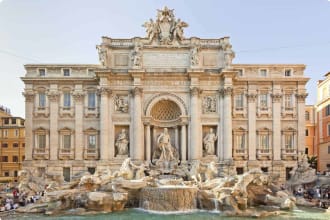
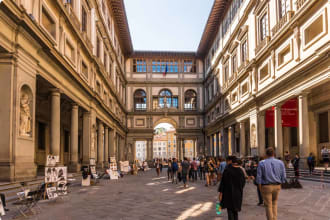
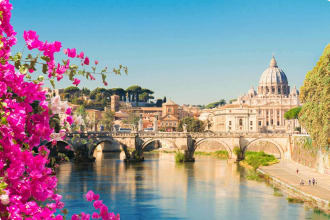


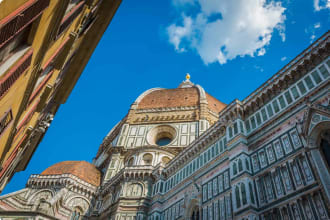
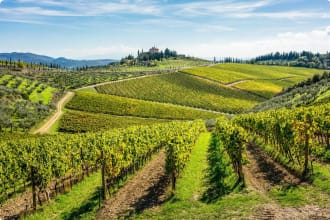
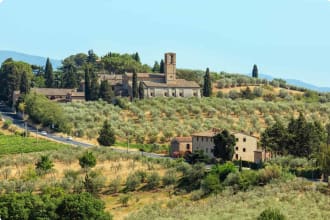
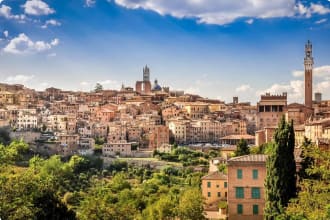
Itinerary
17 days
Day 1: Geneva
Accommodation: Ramada Encore Genève
We make our own way to our hotel in Geneva. The group will meet with the Odyssey Program Leader and sit down for our welcome dinner at the hotel.
(D)
Day 2: Geneva - Lausanne
Accommodation: Swiss Wine Hotel or similar
Today we will be travelling from Geneva to Lausanne, but first we will have a half-day tour of our base city. Geneva, Switzerland’s second largest city, is home to the headquarters of international organisations including the World Health Organisation, and a rich and vibrant counterculture made up of artists and creatives.
We explore its main sights with our local guide and on our touring coach. We will visit Geneva’s Old Town (Vieille Ville) to have a feel of ancient Geneva. The historic district is dominated by St Peter’s Cathedral (St Pierre Cathedral), where Protestant Reformation leader John Calvin once preached in the 16th century. We will visit the cathedral and will also have a chance to go up its two towers (96 steps up the northern tower and 60 steps up the southern tower) for a panoramic view of the city.
We transfer to Lausanne, Switzerland’s fourth largest city and noted for its wine and for being the home of the International Olympic Committee. Here we will go on a cruise of Lake Geneva, the largest lake in Switzerland.
We will have dinner at our accommodation in Lausanne.
(B, D)
Day 3: Lausanne - Montreux - Col du Grand St. Bernard - Aosta
Accommodation: Hotel Express Aosta East or similar
Today we will be beginning our journey on the Via Francigena.
But first, we will transfer to Montreux to have a guided tour of Chateau Chillon, a medieval island castle located on Lake Geneva. The castle was first documented in 1150, a fortification of the Counts of Savoy. Chateau Chillon had an excellent location between the Vaud Riviera (towards Germany and France) and the Rhone Valley, a quick access to Italy. The Counts of Savoy ruled over states that later formed the Kingdom of Italy.
After our tour of the castle, we will travel to Col du Grand Bernard (Great St Bernard Pass) on the Via Francigena. The Great St Bernard Pass is the third highest road pass in Switzerland connecting Martigny in Switzerland to Aosta in Italy. This will be a beautiful drive with views of the snow-covered Alps.
We will take a short walk along the beautiful mountain lake, Lac du St Bernard (Great St Bernard Lake) and visit the St Bernard Monastery (Great St Bernard Hospice), which dates from the 9th century. Located high in the Alps (2,400 metres), it is well known as the home of the large Saint Bernard dog breed, which the monks acquired in the 17th century as their companions and as watch dogs who can rescue people lost in the snow.
We then continue to Aosta, Italy, where we will stay for the night.
(B, D)
Day 4: Aosta - Chatillon - Verres - Ivrea - Pavria
Accommodation: Hotel Excelsior or similar
Today we will be walking a section of the Via Francigena with our local guide, walking from Chatillon through the Aosta Valley to Verres (14 kms., approx. 3 hours). This walk will take us through medieval ruins and a part of the ancient Strada Delle Gallie, an old Roman road that used to connect Paris to Rome.
We will take the touring coach to Ivrea, with a stop to appreciate this 20th-century industrial city developed for Olivetti, manufacturer of typewriters, mechanical calculators and office computers. It was inscribed in 2018 on the UNESCO World Heritage List.
From Ivrea we continue on to Pavia. We will have dinner in our hotel.
(B, D)
Day 5: Pavia - Belgioso - Miradolo Terme - Piacenza
Accommodation: Stadio Hotel or similar
From our hotel in Pavia we transfer to Belgioso, where we begin our walk to Miradolo Terme (10 km, approx 2 1/2 hours), passing through fields dotted with vineyards before arriving at the city centre.
From Miradolo Terme, we ride by coach to Piacenza (“pleasant abode”). Piacenza was originally founded as a Roman military colony (Piacentia, 218 BC) and became the site of the Council of Piacenza. It has notable cathedrals and palaces.
We will have dinner at a local restaurant and stay for the night.
(B, D)
Day 6: Piacenza - Fornovo di Taro - Ozzano Taro - Lucca
Accommodation: Alla corte di Angelie or similar
From Piacenza, we move to Fornovo di Taro, where we will begin our walk to Ozzano Taro (6 kms., approx. 3 hours) through beautiful mountain scenery with a view of the Apennines.
We transfer to Lucca. The charming town of Lucca located at the foot of the Apuan Alps. Colonized by Rome in the early second century BC, Lucca retains its Roman influences in the numerous marble columns of the city’s main square, Piazza San Michele, and in the church of San Michele in Foro from which the piazza takes its name. The church, founded in the 8th century, has an imposing marble statue depicting the archangel Michael defeating a dragon with a spear.
We will have dinner at a local restaurant and stay for the night.
(B, D)
Day 7: Lucca - Massa - Pietrasanta - Pisa - Lucca
Accommodation: Alla corte di Angelie or similar
We travel from Lucca to Massa, to begin our walk to Pietrasanta (12 kms., approx. 3 hours), a town on the northern Tuscany coast. This walk will take us from Massa’s marble monuments, through a hike with views of the Apuan mountains, and to the fine buildings and sculptures of Pietrasanta. The town sits between the Mediterranean and the Apuan Alps, and has attracted artists such as Michelangelo to work with marble, making the town feel like an open-air museum.
In the afternoon, we transfer to Pisa for a walking tour. We will also gain entrance to the Leaning Tower of Pisa.
We return to Lucca for the night.
(B, D)
Day 8: Lucca - Florence - Lucca
Accommodation: Alla corte di Angelie or similar
Today we will have a break from walking the Via Francigena to enjoy a full-day excursion to Florence.
Florence is the capital and most populous city in Tuscany, and attracts millions more people each year. It has been ranked as one of the most beautiful cities in the world, owing in part to its artistic and architectural heritage. Florence was a centre of medieval trade in Europe, and is considered the birthplace of the Renaissance.
On this sightseeing tour, we will visit the city’s main sights, including:
- Uffizi Gallery – “offices”, once the offices of the Florentine magistrates, now housing a large collection of art commissioned or owned by the Medici family, which ruled Florence for the most part of 1434 to 1737
- Ponte Vecchio – a medieval bridge that is the only bridge across the Arno River left intact after World War II
- The iconic Duomo, or the dome of the Cattedrale di Santa Maria del Fiore
We return to Lucca for the night.
(B, D)
Day 9: Lucca - Fuccechio - San Miniato - San Gimignano
Accommodation: Fattoria San Donato or similar
From Lucca we transfer to Fuccechio. From there we walk to San Miniato (8 kms., approx. 2 hours), a medieval town halfway between Pisa and Florence, perched on top of three hills overlooking the verdant fields of the Arno Valley.
We transfer to San Gimignano, where we will stay for the night.
(B, D)
Day 10: San Gimignano - Siena
Accommodation: Garden Hotel or similar
San Gimignano has been a UNESCO World Heritage Site since 1990, and we will have the opportunity this morning to explore the rich architecture and history of this medieval hill town. San Gimignano served as an important relay point for pilgrims travelling on the Via Francigena. We will be able to view the towers that dominate San Gimignano’s landscape. These towers, were built by the families that controlled the town as a symbol of their wealth and power. Of the original 72 tower-houses, 14 survived the test of time.
We then begin our walk to Colle di Val d’Elsa (“Hill of Elsa Valley”, 11 km), leaving San Gimignano behind to pass through three valleys dotted with agricultural land and vineyards. Colle di Val d’Elsa is renowned for its crystal glass production, and its historic centre dating from the Middle Ages, perched on top of a hill offering views of Tuscany.
We transfer to Siena, where we will stay for the night.
In Siena, we will be treated to the city’s magnificent Gothic architecture, preserved through the centuries. Established as the military colony Saena Julia in the first century BC, Siena is a well-loved tourist attraction and home of the famous Palio de Siena, a horse race held twice a year. At the heart of the city is the fan-shaped Piazza del Campo, at the central intersection of the city’s three hillside communities. Siena has the Siena Cathedral (Duomo), with its intricate façade and equally impressive interior decorated with striped marble, and the Santa Maria della Scala, a former hospital now turned museum with an emphasis on its legacy for caring for pilgrims travelling the Via Francigena.
(B, D)
Day 11: Siena - Rigomagno - Lucignano - Siena
Accommodation: Garden Hotel or similar
Today we will transfer to Rigomagno, our starting point for our walk to Lucignano (5 km., approx. 2 hours). Lucignano is a beautiful medieval walled town situated on a hill between Siena and Arezzo, and was the subject of battles between these two cities in the Middle Ages.
We return to Siena after our walk.
(B, D)
Day 12: Siena - Ponte d'Arbia - Sant'Antonio - Orvieto
Accommodation: Oasi dei Discepoli or similar
From Siena, we travel south by coach to Ponte d’Arbia. This drive will take us through Crete Senesi (“Senese clays”), dotted with medieval villages, woods, and the grey clay knolls caused by erosion that give this region its name.
Ponte d’Arbia is named after a five-arched bridge spanning the Arbia, a tributary of the Ombrone River, and is a small part of the municipality Monteroni d’Arbia.
From Ponte d’Arbia, we begin our walk to Sant’Antonio (5 km.), and finish the day in Orvieto, a town located on a 195-metre rock above the junction of two rivers.
(B, D)
Day 13: Orvieto
Accommodation: Oasi dei Discepoli or similar
Orvieto dates from Etruscan times, became a Roman city (Urbs Vetus), and fell under Lombard and Tuscan rule. We will explore this history and more on a walking tour. Our tour includes:
- Entrance to the Orvieto Underground – a subterranean maze of tunnels that began with the Etruscans’ building of cisterns in order to collect rainwater; subsequent inhabitants then continued to dig and add spaces until Orvieto had a network of 1,200 underground structures
- Orvieto’s Cathedral – a Gothic masterpiece
The afternoon is free to spend at leisure.
(B)
Day 14: Orvieto - Viterbo - Rome
Accommodation: Hotel Quirinale or similar
From Orvieto we will be travelling to Rome, the end of the route of the Via Francigena.
Along the way, we will stop at Viterbo, a central Italian city located at the foot of the Cimini Mountains. It once rivaled Rome as the papal residence in the mid-13th century. Viterbo’s walled medieval centre is beautifully preserved, showcasing 13th- and 14th-century houses and palaces.
We will visit
- Villa Lante – a harmonious garden paradise, lauded as the zenith of Mannerist garden design in Italy; it was designed in the 16th century by Giacomo Barozzi da Vignola, for Gianfrancesco Gambara (1533–1587) shortly after the latter’s appointment as cardinal by Pope Pius IV
- Palazzo dei Papi di Viterbo – a former bishops’ palace that was enlarged to serve as a papal residence; the Pope’s residence was moved here in 1257 due to hostility and urban violence in Rome; Viterbo remained the papal seat until 1281
After our tour of Viterbo, we move to Rome, where we will have dinner and stay the night.
(B, D)
Day 15: Rome
Accommodation: Hotel Quirinale or similar
Today is a free day to spend at leisure. Spend this time to relax in your hotel room, or to explore Rome on your own.
Day 16: Rome
Accommodation: Hotel Quirinale or similar
Today we will spend a full day exploring the Eternal City with our local guide.
We will visit:
- Vatican museums including the Sistine Chapel
- St Peter’s Basilica
- Trevi Fountain
- Spanish Steps
- Colosseum (no internal visit)
In the evening, we will have a farewell dinner as a group.
(B, D)
Day 17: Rome
The end of breakfast marks the end of the tour and our services.
(B)
Includes / Excludes
Included
- 16 nights of accommodation, typically 4 stars and well provided 3 star regional accommodation.
- 16 breakfasts, 4 lunches, 10 evening meals.
- Services of a program leader for the duration and expert local guides.
- All transfers and entrances for activities.
- All tipping and gratuities.
- Transportation in a modern air conditioned coach.
- Detailed electronic tour booklet.
Excluded
- Internatioanl flights and airport transfers.
- All items of a personal nature.
- Comprehensive travel insurance.
- Porterage unless specified.
Participants must be in excellent health, extremely mobile and live an active lifestyle. Program activities may include up to 6 hours of continuous strenuous, moderate-to-fast paced activities per day on varied terrain.
Book now
Make it a private tour
Easing your journey
Crossing international borders with restrictions
The list of requirements to travel internationally has changed and will continue to change for several years. Odyssey is here to assist you in managing your way through these requirements:
For more information see our Crossing international borders with restrictions page.
Book With Confidence
If less than 30 days before your tour starts you are unable to travel as a result of Government travel restrictions, Odyssey Traveller will assist you with a date change, provide you with a credit or process a refund for your booking less any non-recoverable costs.
See Terms and conditions for details.
Peace of Mind Travel
The safety of our travellers, tour leader, local guide and support staff has always been our top priority and with the new guidelines for public health and safety for keeping safe for destinations around the world, we’ve developed our plan to give you peace of mind when travelling with us.
See Peace of Mind Travel for details.
Reading List Download PDF
Pilgrimage: The Great Pilgrim Routes of Britain and Europe
Derry Brabbs
Pilgrimage in Europe is thriving on a massive scale. This century the cathedral at Santiago de Compostela alone has seen 40 times the number of pilgrim visits. Author Derry Brabbs’ previous book, Roads to Santiago, focused exclusively on the 'camino' through France and Spain to Santiago de Compostela; Pilgrimage revisits this classic route, and nine other inspirational journeys across Europe.

